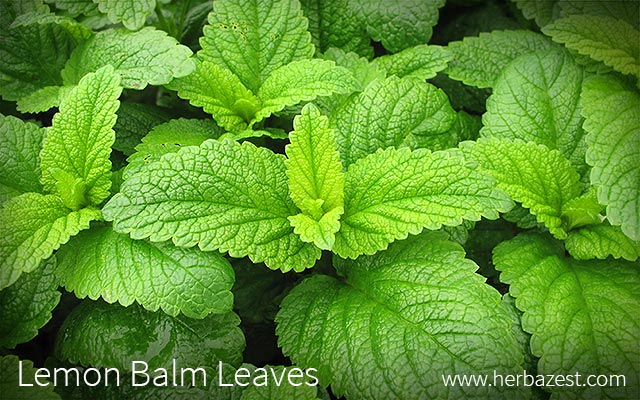The leaves are the most valued part of the lemon balm plant. They not only make a mildly sweet, lemony, and calming infusion, but are also used as a flavoring agent in many culinary recipes. Learn more about the varieties, harvesting, storage, and preparations of lemon balm leaves.
Lemon Balm Leaves' Appearance
Each node of the lemon balm plant has pairs of broadly ovate or heart-shaped leaves, one to two inches (30 - 50 mm) long, shiny on top, with a medium to coarse texture (depending if the plant grows in full sun or partial shade), wrinkled, and deeply veined. The color of the leaves can go from green to variegated light-green-yellow according to the variety of lemon balm:
- 'Aurea' ('Variegata'). This variety is considered the most decorative. It can reach 24 - 39 inches (60 - 100 cm) and its leaves are green, with a variegated yellow pattern and white flowers. It is beautifully scented; however, it does not attract bees or butterflies.
- 'Lime' ('Lime Balm'). This type of lemon balm grows up to 28 - 59 inches (70 - 150 cm) tall. It has shiny green leaves and white-purplish flowers with a gentle lemon scent that attracts bees and butterflies.
- 'All Gold' ('Gold'). This variety of lemon balm has lemon-scented foliage and grows up to 24 inches (60 cm). Great for partial shade, it is also a decorative variety with golden-yellow variegation in early spring that fade during the summer. It has small creamy-white or pale purple flowers that attract pollinators.
Harvesting Lemon Balm Leaves
Since lemon balm is a perennial, leaves can be harvested all year around in temperate climates, and from spring to fall in colder zones. Harvesting is typically done by hand. To make the most of lemon balm's essential oils, it is better to harvest the leaves in the morning during summertime.
How to Preserve and Store Lemon Balm Leaves
The delicate leaves of lemon balm won't last more than two or three days after being harvest before they start showing dark spots. However, there are basically two very easy ways to preserve and store lemon balm leaves:
Drying
The stems with the leaves can then be hung in bunches or placed on trays to dry in a dark place with good air circulation. Then the leaves can be stripped off and stored for one year in a glass container in a dark, dry cabinet. They can also be stored in the refrigerator for a few days or in double bagged food storage plastic bag in the freezer for the short term.
Freezing
Fresh and chopped leaves of lemon balm can be frozen in vegetable oil and used as a cooking ingredient. Another option is freezing the whole or chopped leaves in ice cubes. This way, they can be added to refreshing beverages or infusions.
Preparations with Lemon Balm Leaves
Medicinal preparations
- Infusion. A hot lemon balm tea only requires fresh or dried leaves and boiling water. It will help relieving anxiety, insomnia, and even digestive discomfort.
- Cream. Lemon balm cream can be easily made at home and kept in the fridge to be used on skin lesions, such as eczema, acne, and cold sores.
- Oil. Lemon balm oil is a very simple preparation that can be rubbed over irritated skin or wounds, and also be applied as an insect repellent.
Culinary preparations
- Beverages. Lemon balm syrup can be kept frozen and be added to a lemonade or a cocktail for a refreshing summertime drink.
- Salads. Fresh, whole, or chopped leaves of lemon balm can be added to a sweet or savory salad, both as a garnish and ingredient.
- Desserts. The syrup can also make a great palate-cleansing sorbet between meal courses.
Lemon balm leaves can also be bought dried and whole, as well as in tea bags, alone or mixed with other herbs, in any herbal store, supermarket, or online retailer, so their medicinal properties can be available all year around.
Sources
- Government of South Africa, Department of Agriculture, Forestry and Fisheries Essential Oil Crops - Production guidelines for lemon balm, 2012
- Herb Society of America, Lemon Balm: An Herb Society of America Guide




